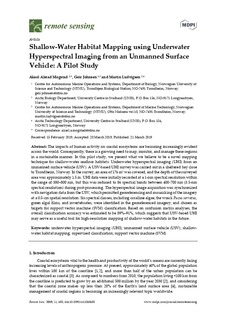| dc.contributor.author | Mogstad, Aksel Alstad | |
| dc.contributor.author | Johnsen, Geir | |
| dc.contributor.author | Ludvigsen, Martin | |
| dc.date.accessioned | 2019-04-11T06:53:38Z | |
| dc.date.available | 2019-04-11T06:53:38Z | |
| dc.date.created | 2019-03-22T09:42:17Z | |
| dc.date.issued | 2019 | |
| dc.identifier.citation | Remote Sensing. 2019, 11 (6), . | nb_NO |
| dc.identifier.issn | 2072-4292 | |
| dc.identifier.uri | http://hdl.handle.net/11250/2594117 | |
| dc.description.abstract | The impacts of human activity on coastal ecosystems are becoming increasingly evident across the world. Consequently, there is a growing need to map, monitor, and manage these regions in a sustainable manner. In this pilot study, we present what we believe to be a novel mapping technique for shallow-water seafloor habitats: Underwater hyperspectral imaging (UHI) from an unmanned surface vehicle (USV). A USV-based UHI survey was carried out in a sheltered bay close to Trondheim, Norway. In the survey, an area of 176 m2 was covered, and the depth of the surveyed area was approximately 1.5 m. UHI data were initially recorded at a 1-nm spectral resolution within the range of 380–800 nm, but this was reduced to 86 spectral bands between 400-700 nm (3.5-nm spectral resolution) during post-processing. The hyperspectral image acquisition was synchronized with navigation data from the USV, which permitted georeferencing and mosaicking of the imagery at a 0.5-cm spatial resolution. Six spectral classes, including coralline algae, the wrack Fucus serratus, green algal films, and invertebrates, were identified in the georeferenced imagery, and chosen as targets for support vector machine (SVM) classification. Based on confusion matrix analyses, the overall classification accuracy was estimated to be 89%–91%, which suggests that USV-based UHI may serve as a useful tool for high-resolution mapping of shallow-water habitats in the future. | nb_NO |
| dc.language.iso | eng | nb_NO |
| dc.publisher | MDPI | nb_NO |
| dc.relation.uri | https://www.mdpi.com/2072-4292/11/6/685 | |
| dc.rights | Navngivelse 4.0 Internasjonal | * |
| dc.rights.uri | http://creativecommons.org/licenses/by/4.0/deed.no | * |
| dc.title | Shallow-Water Habitat Mapping using Underwater Hyperspectral Imaging from an Unmanned Surface Vehicle: A Pilot Study | nb_NO |
| dc.type | Journal article | nb_NO |
| dc.type | Peer reviewed | nb_NO |
| dc.description.version | publishedVersion | nb_NO |
| dc.source.pagenumber | 19 | nb_NO |
| dc.source.volume | 11 | nb_NO |
| dc.source.journal | Remote Sensing | nb_NO |
| dc.source.issue | 6 | nb_NO |
| dc.identifier.doi | https://doi.org/10.3390/rs11060685 | |
| dc.identifier.cristin | 1686942 | |
| dc.relation.project | Norges forskningsråd: 223254 | nb_NO |
| dc.description.localcode | © 2019 by the authors. Licensee MDPI, Basel, Switzerland. This article is an open access article distributed under the terms and conditions of the Creative Commons Attribution (CC BY) license (http://creativecommons.org/licenses/by/4.0/). | nb_NO |
| cristin.unitcode | 194,66,10,0 | |
| cristin.unitcode | 194,64,20,0 | |
| cristin.unitname | Institutt for biologi | |
| cristin.unitname | Institutt for marin teknikk | |
| cristin.ispublished | true | |
| cristin.fulltext | original | |
| cristin.qualitycode | 1 | |

